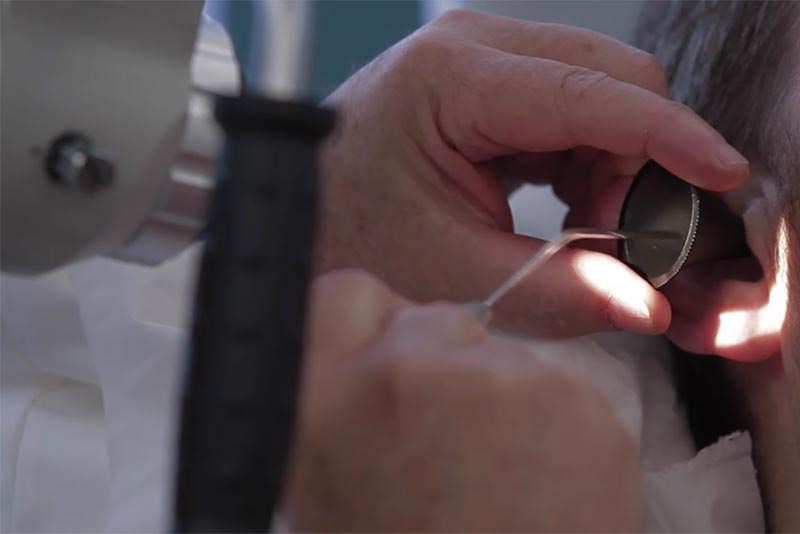
Wax removal using the microsuction method
Wax removal using the microsuction method
We’ve all heard of ear wax and ear wax removal- most of us have seen our own ear wax at some point. We know it as the yellowy, brown substance – not too appealing to look at and perhaps even a source of embarrassment if it becomes visible! However, this yellowy substance has more to it than meets the eye.
Ear microsuction is the most effective and safest form of earwax removal as it avoids touching the sensitive area around the ear canal and evades contact with the ear drum. A low pressure suction probe is used to gently and safely remove earwax. This technique of ear wax removal does not use high pressure water unlike ‘syringing’, therefore allowing microsuction to be the safest, fastest and cleanest method of choice.
The procedure is traditionally performed by ent doctors or nurses via the nhs using high-magnification binocular operating microscopes, although there is a growing number of private audiologists and hearing aid dispensers in the uk now also performing microscopic and microsuction ear wax removal using magnifying glasses (loupes). Loupes are limited in the terms of both the magnification and distance (depth) of view they can provide inside the ear. However they remain popular due to their portability and relative inexpensive compared to an operating microscope. Both operating microscopes and loupes provide stereoscopic vision which aids depth perception.
Microsuction is a wax removal technique using a very fine sterile suction device under a microscope. The gentle suction device is used to provide pain free and immediate results, and whilst using the microscope the audiologist can clearly see inside the ear canal during the procedure making it an entirely controlled treatment.
A Good View of The Ear Canal
Unlike ear syringing or even the safer ear irrigation, there is no water used, which means less mess generally. When undertaking micro-suction, the canal and the ear wax is being directly viewed with a microscope or a set of loupes (microscopic glasses) whilst it is being removed. This makes the procedure much quicker, safer and comfortable for the patient.
Earwax should be removed if it is totally blocking the ear canal and one of the following: the person is symptomatic (with conductive hearing loss, earache, tinnitus or vertigo) the tympanic membrane is obscured by wax but needs to be viewed to establish a diagnosis the person wears a hearing aid and an impression needs to be taken for a mould, or wax is causing the hearing-aid to whistle.
Microsuction uses a binocular microscope which gives us an especially good view of both the ear canal and any ear wax obstruction. This means we have a clear view of what we are doing, making it much safer and easier to do.
We also use endoscopic ear wax removal at our practices and to learn more, please contact us. Ear wax, or “cerumen” to use the medical term, is a good thing to have in our ears. This is because it protects the skin of the human ear canal and it also assists in cleaning and lubrication.
As the name suggests, microsuction employs a tiny suction tube to gently remove excess wax from your ear canal. We also use a microscope to target locations where wax has built up. Because we have a better view of your ear, microsuction is faster than irrigation, typically lasting just a few minutes. It is generally considered free from discomfort and like irrigation we usually ask that you use sodium bicarbonate eardrops beforehand.
Microsuction is the term used for cleaning ear canals under the magnified view of a surgical microscope, and using a tiny vacuum cleaner and/or tiny instruments to remove ear wax.
The Benefits of Microsuction Ear Wax Removal
Wax microsuction is the gold standard ear wax removal technique. It involves the use of an air suction device at low operating pressure to remove wax from the ear, all performed under an operating microscope. It is the safest and quickest means to conveniently remove ear wax and allows full visualisation of the ear canal so that any touching of the sensitive skin layer or fine hairs within the ear canal can, in most instances, be avoided. It is advised that wax softening drops (such as earol) are used by patients a few days prior to attending for wax removal.
Microsuction ear wax removal is a procedure that uses gentle suction to remove excessive or troublesome ear wax. Using a microscope, our trained audiologists are able to look directly into the ear canal and use a sterile suction device to gently remove the wax. Occasionally we may need to use other instruments to remove hard wax, or to soften the wax using olive oil.
Microsuction is a procedure which uses gentle suction to remove excessive or troublesome earwax. It is performed with the aid of an operating microscope and a finely calibrated suction device, without the introduction of any materials or liquids. You may be asked to use olive oil spray or drops for several days beforehand. This will make the treatment easier for you. Occasionally we may need to use other instruments to remove hard wax. The technique means that we can always see what we are doing and can avoid touching the skin of the sides of the ear canal which makes the process a lot more comfortable.
Microsuction is a safe wax-removal technique using specialised a high magnification binocular operating microscope allowing depth-perception and magnification to look directly into the ear canal. The clinician then uses a very fine sterile suction device at safe low pressure to remove the wax buildup.
Click the link for further information, or to make an enquiry
